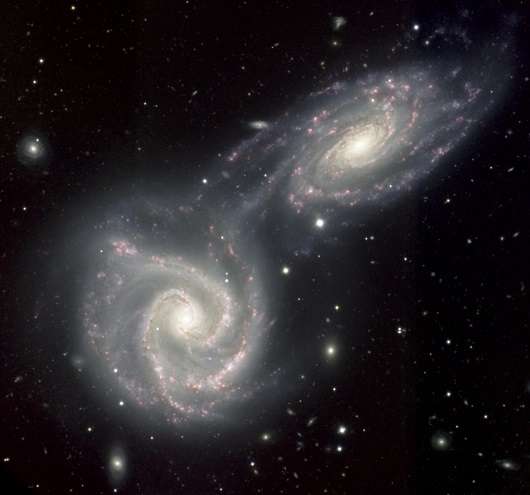Running away from Einstein

Einstein's theory of gravity may have to be rewritten, after researchers at the University of St Andrews found a gigantic ring of galaxies darting away from us much faster than predicted.
This 10 million light year-wide ring made up of small galaxies is expanding rapidly like a mini Big Bang. The team believe our neighbouring galaxy, Andromeda, once flew past our own galaxy at close range, creating a sling-shot of several small galaxies.
Dr Hongsheng Zhao, Reader in the School of Physics and Astronomy and co-author of the paper, published in Monthly Notices of the Royal Astronomical Society by Oxford University Press, said: "If Einstein's gravity were correct, our galaxy would never come close enough to Andromeda to scatter anything that fast."
If true, the discovery would force a new understanding of gravity and about our cosmos, as such a galactic flyby only makes sense if gravity weakens more slowly as galaxies drift apart than mainstream thinking suggests.
Indranil Banik, the PhD student who led the study, said: "The ring-like distribution is very peculiar. These small galaxies are like a string of raindrops flung out from a spinning umbrella. I found there is barely a 1 in 640 chance for randomly distributed galaxies to line up in the observed way. I traced their origin to a dynamical event when the Universe was only half its present age."
This tsunami-like wake in the sky was likely stirred up by a near-miss of the speeding Andromeda galaxy with our own galaxy, the Milky Way. The two massive galaxies always orbited each other in a plane and would have scattered dwarf galaxies in their paths, perhaps explaining why the speeding dwarfs are in a plane also containing the Milky Way and Andromeda.
Mr Banik added: "In Einstein's gravity paradigm, hypothetical dark matter is always invoked. Such a high speed requires 60 times the mass we see in the stars of the Milky Way and Andromeda. However, the friction between their huge halos of dark matter would result in them merging rather than flying 2.5 million light years apart, as they must have done."
"Science progresses through challenges," said Marcel Pawlowski, a Hubble Fellow at the University of California, Irvine, who prompted Mr Banik's discovery. "Together with two other known planes of closer-in satellites, this gigantic ring forms a serious challenge to the standard paradigm."
More information: Indranil Banik et al. Dynamical History Of The Local Group In ΛCDM slowromancapii@ − Including External Perturbers In 3D, Monthly Notices of the Royal Astronomical Society (2017). DOI: 10.1093/mnras/stx151
Anisotropic Distribution of High Velocity Galaxies in the Local Group: arxiv.org/abs/1701.06559
Journal information: Monthly Notices of the Royal Astronomical Society
Provided by University of St Andrews




















